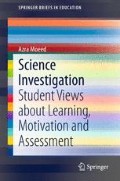Abstract
The overarching aim of the research was to understand the connectedness between motivation to learn, learning, and assessment of science investigation within year 11 school science. Within this lay the construct of a case study of the phenomenon of school science investigation from the students’ perspective. It became clear that motivation to learn, learning and assessment did not stand alone at any time during the study and that there was a need to look through students’ eyes, minds, and words at the complexity of the learning that ensued. The themes are discussed followed by conclusions relating to the overall research questions are reported. The chapter finishes with the final thoughts about what the findings may mean for practice.
Access this chapter
Tax calculation will be finalised at checkout
Purchases are for personal use only
References
Abrahams, I., & Millar, R. (2008). Does practical work really work? A study of the effectiveness of practical work as a teaching and learning method in school science. International Journal of Science Education, 30(14), 1945–1969. doi:10.1080/09500690701749305.
Alexander, P. A., Kulikowich, J. M., & Jetton, T. L. (1994). The role of subject-matter knowledge and interest in the processing of linear and nonlinear texts. Review of Educational Research, 64, 201–252.
Anderson, L. W., & Krathwohl, D. R. (Eds.). (2001). A taxonomy for learning, teaching, and assessing: A revision of bloom’s taxonomy of educational objectives. New York: Longman.
Bloom, B., Englehart, M., Furst, E., Hill, W., & Krathwohl, D. (1956). Taxonomy of educational objectives: The classification of educational goals. Handbook I: Cognitive domain. New York: Longman.
Cleaves, A., & Toplis, R. (2007). Assessment of practical and enquiry skills: Lessons to be learnt from pupils’ views. School Science Review, 88(325), 91–96.
Eccles, J. S., & Wigfield, A. (2002). Motivational belief, values, and goals. Annual Review of Psychology, 53, 109–132.
Entwistle, N. (2005). Learning and studying: Contrasts and influences. Retrieved September 8, 2005, from http://www.newhorizons.org/future/Creating_the_Future/crfut_entwi9stle.html.
Entwistle, N., & Ramsden, P. (1983). Understanding student learning. London: Croom Helm.
Fraser, B. J., McRobbie, C. J., & Giddings, G. J. (1995). Development and cross-national validation of a laboratory classroom environment instrument for senior high school science. Science Education, 77, 1–24. doi:10.1002/sce.3730770102.
Gott, R., & Duggan, S. (2002). Problems with the assessment of performance in practical science: Which way now? Cambridge Journal of Education, 32(2), 183–201.
Hall, C. (2007). Qualitative research designs. Wellington: School of Education Studies, Victoria University of Wellington (unpublished lecture notes).
Harlen, W. (2005). Trusting teachers’ judgement: Research evidence of the reliability and validity of teachers’ assessment used for summative purposes. Research Papers in Education, 20(3), 245–270.
Hodson, D. (1993). Rethinking old ways: Towards a more critical approach to practical work in school science. Studies in Science Education, 22, 85–142.
Hodson, D. (2014). Learning science, learning about science, doing science: Different goals demand different learning methods. International Journal of Science Education.
Hume, A., & Coll, R. (2008). Student experiences of carrying out a practical science investigation under direction. International Journal of Science Education, 30(9), 1201–1228.
Izard, C. E. (1977). Human emotions. New York: Plenum Press.
Keiler, L. S., & Woolnough, B. E. (2002). Practical work in school science: The dominance of assessment. School Science Review, 83(304), 83–88.
Kraska, M. (2008). Assessment. In N. J. Salkind (Ed.), Encyclopedia of educational psychology. Retrieved September 11, 2009, from http://www.sage-ereference.com/educationalpsychology/Article_n17.html.
Lederman, N. G., Antink, A., & Bartos, S. (2014). Nature of science, scientific inquiry, and socio-scientific issues arising from genetics: A pathway to developing a scientifically literate citizenry. Science and Education, 23(2), 285–302.
Millar, R. (2004). The role of practical work in the teaching and learning of science. In Paper presented for the meeting of high school science laboratories: Role and vision. Washington: National Academy of Sciences
Ministry of Education (1993). Science in the New Zealand curriculum. Wellington: Learning Media.
New Zealand Qualifications Authority. (2005). Achievement Standard 1.1. Retrieved June 24, 2009, from http://www.nzqa.govt.nz/ncea/assessment/search.do?query=Science&view=achievements&level=01.
Palmer, D. H. (2009). Students interest generated during an inquiry skills lesson. Journal of Research in Science Teaching, 46(2), 147–165.
Rennie, L. J., Goodrum, D., & Hackling, M. (2001). Science teaching and learning in Australian schools: Results of a national study. Research in Science Education, 31, 455–498.
Roberts, R. (2009). Can teaching about evidence encourage a creative approach in open-ended investigations? School Science Review, 90(332), 31–38.
Rotgans, J. I., & Schmidt, H. G. (2014). Situational interest and learning: Thirst for knowledge. Learning and Instruction, 32, 37–50.
Roth, W.-M. (1994). Experimenting in a constructivist high school physics laboratory. Journal of Research in Science Teaching, 31, 197–223.
Toplis, R. (2004). What do key stage 4 pupils think about science investigations? Science Teacher Education, 41, 8–9.
Watson, R., Goldsworthy, A., & Wood-Robinson, V. (1999). What is not fair with investigations? School Science Review, 80(292), 101–106.
Wellington, J. (1998). Practical work in science: Time for re-appraisal. In J. Wellington (Ed.), Practical work in science. Which way now? (pp. 3–15). London: Routledge.
Wellington, J. (2005). Practical work and the affective domain: What do we know, what should we ask, and what is worth exploring further? In S. Alsop (Ed.), Beyond cartesian dualism (pp. 99–109). Netherlands: Springer.
Author information
Authors and Affiliations
Corresponding author
Rights and permissions
Copyright information
© 2015 The Author(s)
About this chapter
Cite this chapter
Moeed, A. (2015). Discussion and Conclusion. In: Science Investigation. SpringerBriefs in Education. Springer, Singapore. https://doi.org/10.1007/978-981-287-384-2_5
Download citation
DOI: https://doi.org/10.1007/978-981-287-384-2_5
Published:
Publisher Name: Springer, Singapore
Print ISBN: 978-981-287-383-5
Online ISBN: 978-981-287-384-2
eBook Packages: Humanities, Social Sciences and LawEducation (R0)

